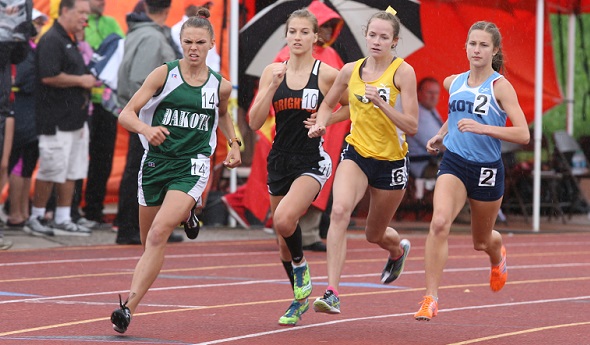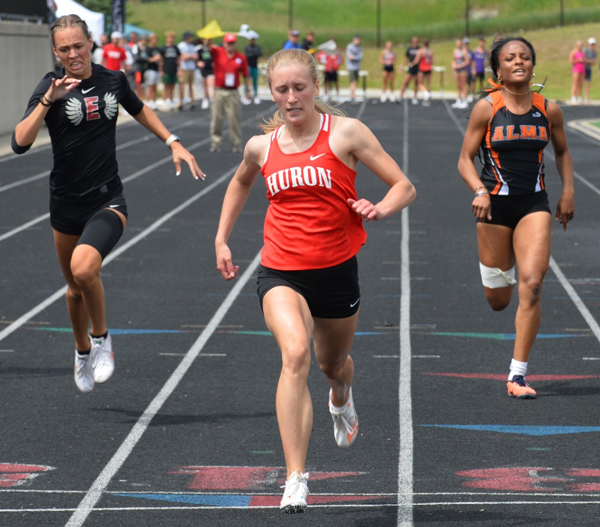
Health Challenges Can't Ground Dobies
By
Tom Markowski
Special for Second Half
May 18, 2016
MACOMB TOWNSHIP – Look at Kayla Dobies and one can see a vibrant young woman with an engaging personality that locks on to those around her.
 Look at Dobies’ accomplishments, athletically and academically, and one will marvel at her ingenuity and perseverance.
Look at Dobies’ accomplishments, athletically and academically, and one will marvel at her ingenuity and perseverance.
Hidden are ailments that would prevent a lesser person from achievements that flow from Dobies in a variety of forms.
Dobies, 18, is a senior at Macomb Dakota and has been accepted to Princeton University. In addition to her studies, Dobies plans on competing collegiately in cross country and track and field. The high jump is her best event – her best is a jump of 5 feet, 7 inches. But she is also a fine distance runner. Dobies placed eighth in Lower Peninsula Division 1 her freshman season in the high jump and was all-state again her junior season as she placed fourth in the 800-meter run.
Her best cross country time is 18:27, a school record. She qualified for the MHSAA Finals in cross country her junior and senior seasons but failed to place. The reasons will become obvious later.
For six years she practiced taekwondo and holds a first and second degree black belt in the sport.
As a junior she started a robotics team at Dakota, but did not compete. Although Dakota did not fare well in the state competition this year, the team competed at the world championships, a four-day event held in late April, in St. Louis, and won. The name of the team is the Thunder Chickens, and among Dobies’ responsibilities was as an assistant mechanic. When one of the machines broke down, she would assist in fixing it, thus earning the nickname, ‘Baby Chicken’.
Dobies has a 4.07 grade-point average entering her final semester and scored a 33 on her ACT. She was named a winner this winter of the MHSAA/Farm Bureau Insurance Scholar-Athlete Award and was one of six finalists for the recently-awarded Detroit Athletic Club Female High School Athlete of the Year.
She plans on entering the pre-med program at Princeton and possibly majoring in neuroscience.
As impressive as is her list of accomplishments, Dobies often has had to miss competing because of her illnesses. Every day Dobies confronts them. She tries to hold them off with daily medication, and sometimes even that doesn’t work.
Topping this list, Dobies is an asthmatic. Offshoots are the allergies from which she suffers. She’s also anemic and suffers from hypoglycemia, a blood sugar disorder. She can’t eat candy. She can only consume pure sugar. And she can’t eat fast food or pizza, or other like fatty foods because of their trans-fatty acids.
It’s the pizza part that upsets Dobies most, even as that seems like one of the lesser obstacles she continuously must hurdle.
“I have every type of asthma you can imagine,” she said. “I use a breathing machine at night and two inhalers every day. I get allergy shots. I’m allergic to mites. I have to have special sheets on my bed to help prevent an attack.”
The attacks continue to occur. The reason she did not compete in robotics her junior year was her health. Most days, Dobies is fine. The medication she takes helps combat her diseases, but it’s not foolproof. When the seasons change, Dobies suffers most.
A leg injury kept Dobies from possibly making all-state in cross country her junior year, and this past November she suffered an asthma attack at the MHSAA Finals. Though cross country and running in general is one of her favorite sports, fall changing to winter is the worst season for Dobies.
“When others are improving their times, my times get worse,” she said. “I was in the hospital a couple of days during the cross country season. When I have an asthma attack, it’s not fun.”
Because of her condition, Dobies prefers to run in warm weather – the hotter the better. That’s why she’s hoping for warm weather, at least warmer weather, Saturday when Dakota competes at the Division 1 Track & Field regional at Warren Mott.
 The spring didn't start well for Dobies. She suffered a pulled quadriceps (right leg) in the first meet of the season, and it wasn’t until three weeks ago that she could run the way she knows she can.
The spring didn't start well for Dobies. She suffered a pulled quadriceps (right leg) in the first meet of the season, and it wasn’t until three weeks ago that she could run the way she knows she can.
“I’m better now,” she said. “I’ve just got to get my times to drop.”
No one will doubt that she will. Dobies has always been highly motivated. This comes from her parents, Jeff and Jody Dobies, and she’s received a push from others including Dakota assistant track coach Tom Zarzycki. Jeff Dobies introduced his eldest daughter to soccer when she was 2 years old, and sports has been a big part of her life ever since.
“I watched the Olympics at Beijing and I saw the high jump,” she said. “I said, I can do that. So I asked my dad, what’s that? And he told me it was the high jump.”
Ever the inquisitive child, Dobies was inspired after viewing the Disney animated film “Mulan” to try martial arts.
“I’ve always liked sports,” she said. “I’m really, really passionate about everything. Take robotics and martial arts. I figure if you’re going to do something, do your best.
“Like running. I love to run. High jump is the reason I got into running. It gets down to a deep level. I just love running. I love running with my friends. I love running to compete.”
Whatever the task, whatever the challenge, anything Dobies dives into she gives it her best.
Her most recent project is experimenting with rats. It’s a class project, one she must complete to earn a grade. What she’s attempting to prove, with the aid of the rats, is that fear is innate.
“I’m still working on it,” she said. “I don’t expect to change the world.”
But she might.
 Tom Markowski is a columnist and directs website coverage for the State Champs! Sports Network. He previously covered primarily high school sports for the The Detroit News from 1984-2014, focusing on the Detroit area and contributing to statewide coverage of football and basketball. Contact him at [email protected] with story ideas for Oakland, Macomb and Wayne counties.
Tom Markowski is a columnist and directs website coverage for the State Champs! Sports Network. He previously covered primarily high school sports for the The Detroit News from 1984-2014, focusing on the Detroit area and contributing to statewide coverage of football and basketball. Contact him at [email protected] with story ideas for Oakland, Macomb and Wayne counties.
PHOTOS: (Top) Macomb Dakota's Kayla Dobies (14) rounds the bend ahead of three competitors during the 800 at last season's Lower Peninsula Division 1 Final. (Middle) Dobies stands with other Scholar-Athlete Award winners in March at the Breslin Center. (Top photo by Carter Sherline/RunMichigan.com.)

Multi-Sprint Champ Racing to Finish Huron Career Ahead of the Rest Again
By
Keith Dunlap
Special for MHSAA.com
May 25, 2023
NEW BOSTON – If there was one thing Elizabeth Anderson took pride in elementary school, it was simply showing that she could outrun everyone in sight.
 In fact, Anderson has an explanation for all the success she had in those playground races.
In fact, Anderson has an explanation for all the success she had in those playground races.
“Dominance when you are in elementary school,” Anderson quipped. “I don’t think I ever had a nickname. I just think everyone knew I was fast.”
Years later, pretty much everyone who follows track & field in the state of Michigan can attest to that.
A senior for New Boston Huron, Anderson has been faster than most other competitors in the state during her three-year high school career (with her freshman season in 2020 canceled due to COVID-19).
Last year, Anderson won titles at the Lower Peninsula Division 2 Finals in the 200-meter (25.07) and 400-meter (56.28) dashes, and was runner-up in the 100-meter dash (12.23).
Often, top sprinters focus on one or two of those three races. But Anderson is certainly a different breed of sprinter because she does all three.
In fact, she holds school records in all three of those events, and if all that weren’t enough, Anderson is a part of all three sprint relay teams.
“It is hard to give her events off,” said New Boston Huron head girls track coach Danielle Lobato.
Despite the different styles the 100, 200 and 400-meter dashes present, Anderson said there usually isn’t much adjusting when she goes from one of those races to another.
 The strategy is simply, “Let’s beat the other girls to the finish line.”
The strategy is simply, “Let’s beat the other girls to the finish line.”
“I don’t really go into each race changing up how I would run,” she said.
While enjoying and succeeding in all three races, Anderson said she actually does have a favorite among them.
“I would say the 400 is probably my favorite,” she said. “Even though it hurts, it’s satisfying to see how much you can get your time down in the 400 compared to any other race.”
Anderson said she started running track in sixth grade, but really got serious about it during the summer after her sophomore season, when she was invited to run for a local club.
Eventually, that led to her competing over the winter in indoor events.
She lived and breathed track so much that last fall, she decided to not run cross country so she could focus on a weightlifting regimen aimed at developing more leg strength.
“Once I started doing summer track, I realized I wanted to be doing this all the time,” she said.
Lobato said oftentimes in practice, Anderson is a de facto coach, given there is no better person she can think of for the younger runners on the team to learn from.
“I can’t always demonstrate these things I’m trying to teach,” she said. “You get to see it in real life (from Anderson), not in a YouTube video.”
After winning the 100, 200 and 400-meter dashes at her Regional meet last week, Anderson has her sights set on achieving the same trifecta of titles at next Saturday’s Finals in Grand Rapids.
Anderson has signed to run track at Michigan State, but has been plenty motivated to keep producing this spring in her final high school season.
“I’m really looking to defend my titles,” she said. “That is what is really motivating me to keep going. I want to keep in shape for the college season. I don’t want to lose any of the progress I have made. Ultimately, I just love running track.”
And since elementary school, Anderson has loved — and succeeded in — outrunning everyone else to the finish line.
“We knew we were getting something special,” Lobato said of when Anderson arrived in high school. “But you never expect this. All that she has accomplished is amazing.”
 Keith Dunlap has served in Detroit-area sports media for more than two decades, including as a sportswriter at the Oakland Press from 2001-16 primarily covering high school sports but also college and professional teams. His bylines also have appeared in USA Today, the Washington Post, the Detroit Free Press, the Houston Chronicle and the Boston Globe. He served as the administrator for the Oakland Activities Association’s website from 2017-2020. Contact him at [email protected] with story ideas for Oakland, Macomb and Wayne counties
Keith Dunlap has served in Detroit-area sports media for more than two decades, including as a sportswriter at the Oakland Press from 2001-16 primarily covering high school sports but also college and professional teams. His bylines also have appeared in USA Today, the Washington Post, the Detroit Free Press, the Houston Chronicle and the Boston Globe. He served as the administrator for the Oakland Activities Association’s website from 2017-2020. Contact him at [email protected] with story ideas for Oakland, Macomb and Wayne counties
PHOTOS (Top) New Boston Huron's Elizabeth Anderson clears the finish line during last season's LPD2 400 race. (Middle) Anderson, middle, outpaces the field to also win the 200. (Click for more from RunMichigan.com.)

